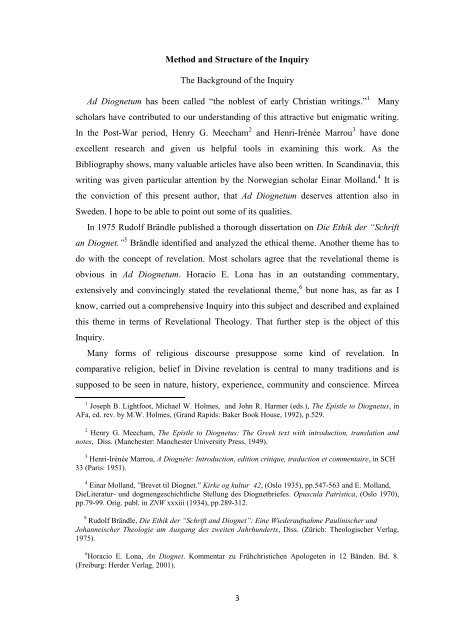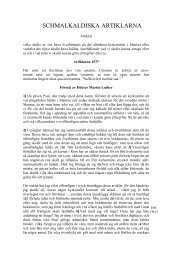MYSTERY REVEALED
MYSTERY REVEALED
MYSTERY REVEALED
Create successful ePaper yourself
Turn your PDF publications into a flip-book with our unique Google optimized e-Paper software.
Method and Structure of the Inquiry<br />
The Background of the Inquiry<br />
Ad Diognetum has been called “the noblest of early Christian writings.” 1 Many<br />
scholars have contributed to our understanding of this attractive but enigmatic writing.<br />
In the Post-War period, Henry G. Meecham 2 and Henri-Irénée Marrou 3 have done<br />
excellent research and given us helpful tools in examining this work. As the<br />
Bibliography shows, many valuable articles have also been written. In Scandinavia, this<br />
writing was given particular attention by the Norwegian scholar Einar Molland. 4 It is<br />
the conviction of this present author, that Ad Diognetum deserves attention also in<br />
Sweden. I hope to be able to point out some of its qualities.<br />
In 1975 Rudolf Brändle published a thorough dissertation on Die Ethik der “Schrift<br />
an Diognet.” 5 Brändle identified and analyzed the ethical theme. Another theme has to<br />
do with the concept of revelation. Most scholars agree that the revelational theme is<br />
obvious in Ad Diognetum. Horacio E. Lona has in an outstanding commentary,<br />
extensively and convincingly stated the revelational theme, 6 but none has, as far as I<br />
know, carried out a comprehensive Inquiry into this subject and described and explained<br />
this theme in terms of Revelational Theology. That further step is the object of this<br />
Inquiry.<br />
Many forms of religious discourse presuppose some kind of revelation. In<br />
comparative religion, belief in Divine revelation is central to many traditions and is<br />
supposed to be seen in nature, history, experience, community and conscience. Mircea<br />
1 Joseph B. Lightfoot, Michael W. Holmes, and John R. Harmer (eds.), The Epistle to Diognetus, in<br />
AFa, ed. rev. by M.W. Holmes, (Grand Rapids: Baker Book House, 1992), p.529.<br />
2 Henry G. Meecham, The Epistle to Diognetus: The Greek text with introduction, translation and<br />
notes, Diss. (Manchester: Manchester University Press, 1949).<br />
3 Henri-Irénée Marrou, A Diognète: Introduction, edition critique, traduction et commentaire, in SCH<br />
33 (Paris: 1951).<br />
4 Einar Molland, ”Brevet til Diognet.” Kirke og kultur 42, (Oslo 1935), pp.547-563 and E. Molland,<br />
DieLiteratur- und dogmengeschichtliche Stellung des Diognetbriefes. Opuscula Patristica, (Oslo 1970),<br />
pp.79-99. Orig. publ. in ZNW xxxiii (1934), pp.289-312.<br />
5 Rudolf Brändle, Die Ethik der “Schrift and Diognet”: Eine Wiederaufnahme Paulinischer und<br />
Johanneischer Theologie am Ausgang des zweiten Jahrhunderts, Diss. (Zürich: Theologischer Verlag,<br />
1975).<br />
6 Horacio E. Lona, An Diognet. Kommentar zu Frühchristichen Apologeten in 12 Bänden. Bd. 8.<br />
(Freiburg: Herder Verlag, 2001).<br />
3



